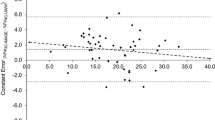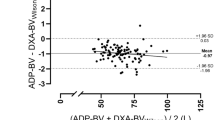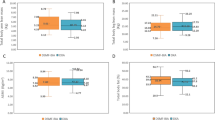Abstract
This scoping review aimed to assess the repeatability and accuracy of Digital Anthropometry by Mobile Application (DAM) compared to reference methods for estimating anthropometric dimensions, body volume (BV), and body composition. A comprehensive search was conducted on December 8th, 2024, without restrictions on language, time, sex, ethnicity, age, or health condition. We found 14 different DAMs across the 23 included studies. Reference methods for each estimated variable were: (a) Body circumferences—tape measure; (b) body mass—calibrated scale; (c) body length—stadiometer; (d) BV—Underwater Weighing; (e) percentage of body fat—Dual energy x-ray absorptiometry (DXA), BOD POD, 3, 4, and 5-compartment models; (f) fat mass and fat-free mass—DXA, 3 and 4-compartment models; (g) appendicular Lean Mass—DXA. DAMs demonstrated high repeatability and accuracy at a mean level in most studies. However, their accuracy is lower at individual-level analysis and for tracking changes over time. Estimated BV showed high accuracy compared to UWW (SEE = 0.68; MD = 0.04 to 0.1; LoA = 2.86), including the BV-derived DAMs integrated into alternative multi-compartment models compared to reference methods. As relatively new methods, DAMs offer numerous possibilities and areas for exploration in future studies. However, caution is advised due to their potentially low or unknown accuracy at the individual level.
This is a preview of subscription content, access via your institution
Access options
Subscribe to this journal
Receive 12 print issues and online access
$259.00 per year
only $21.58 per issue
Buy this article
- Purchase on SpringerLink
- Instant access to full article PDF
Prices may be subject to local taxes which are calculated during checkout

Similar content being viewed by others
Data availability
All data analysed during this study are included in this published article and its supplementary information files.
References
Cerqueira MS, Amorim PR dos S, Encarnação IGA, Rezende LMT, et al. Equations based on anthropometric measurements for adipose tissue, body fat, or body density prediction in children and adolescents: a scoping review. Eating and Weight Disorders - Studies on Anorexia, Bulimia and Obesity. 2022;27: 2321–38.
Heymsfield SB, Stevens J. Anthropometry: continued refinements and new developments of an ancient method. Am J Clin Nutr. 2017;105:1–2.
Minetto MA, Pietrobelli A, Busso C, Bennett JP, Ferraris A, Shepherd JA, et al. Digital Anthropometry for Body Circumference Measurements: European Phenotypic Variations throughout the Decades. J Personalized Med. 2022;12:906.
Morze J, Rücker G, Danielewicz A, Przybyłowicz K, Neuenschwander M, Schlesinger S, et al. Impact of different training modalities on anthropometric outcomes in patients with obesity: A systematic review and network meta-analysis. Obes Rev. 2021;22:e13218.
Wang ZM, Pierson RN Jr, Heymsfield SB. The five-level model: a new approach to organizing body-composition research. Am J Clin Nutr. 1992;56:19–28.
Vegelin AL, Brukx LJCE, Waelkens JJ, Van den Broeck J. Influence of knowledge, training and experience of observers on the reliability of anthropometric measurements in children. Ann Hum Biol. 2003;30:65–79.
Jones PRM, West GM, Harris DH, Read JB. The loughborough anthropometric shadow scanner (LASS). Endeavour. 1989;13:162–8.
Heymsfield SB, Bourgeois B, Ng BK, Sommer MJ, Li X, Shepherd JA. Digital anthropometry: a critical review. Eur J Clin Nutr. 2018;72:680–7.
Haleem A, Mohd Javaid. 3D scanning applications in medical field: A literature-based review. Clin Epidemiol Glob Health. 2019;7:199–210.
Orsso CE, Silva MIB, Gonzalez MC, Rubin DA, Heymsfield SB, Prado CM, et al. Assessment of body composition in pediatric overweight and obesity: A systematic review of the reliability and validity of common techniques. Obes Rev. 2020;21:e13041.
Mocini E, Cammarota C, Frigerio F, Muzzioli L, Piciocchi C, Lacalaprice D, et al. Digital anthropometry: a systematic review on precision, reliability and accuracy of most popular existing technologies. Nutrients. 2023; 15. https://doi.org/10.3390/nu15020302.
Macdonald EZ, Vehrs PR, Fellingham GW, Eggett D, George JD, Hager R. Validity and reliability of assessing body composition using a mobile application. Med Sci Sports Exerc. 2017;49:2593–9.
Smith B, McCarthy C, Dechenaud ME, Wong MC, Shepherd J, Heymsfield SB. Anthropometric evaluation of a 3D scanning mobile application. Obes (Silver Spring. 2022;5:1–11.
Majmudar MD, Chandra S, Yakkala K, Kennedy S, Agrawal A, Sippel M, et al. Smartphone camera based assessment of adiposity: a validation study. NPJ Digital Med. 2022;5:1–11.
Tricco AC, Lillie E, Zarin W, O’Brien KK, Colquhoun H, Levac D, et al. PRISMA extension for scoping reviews (PRISMA-ScR): checklist and explanation. Ann Intern Med. 2018;169:467–73.
Moher D, Booth A, Stewart L. How to reduce unnecessary duplication: use PROSPERO. BJOG. 2014;121:784–6.
Graybeal AJ, Brandner CF, Tinsley GM. Validity and reliability of a mobile digital imaging analysis trained by a four-compartment model. J Hum Nutr Diet. 2022. https://doi.org/10.1111/jhn.13113.
Ouzzani M, Hammady H, Fedorowicz Z, Elmagarmid A. Rayyan-a web and mobile app for systematic reviews. Syst Rev. 2016;5:210.
Smith MK, Staynor JMD, El-Sallam A, Ebert JR, Ackland TR. Longitudinal concordance of body composition and anthropometric assessment by a novel smartphone application across a 12-week self-managed weight loss intervention. Br J Nutr. 2023;1–7.
Farina GL, Spataro F, De Lorenzo A, Lukaski H. A smartphone application for personal assessments of body composition and phenotyping. Sensors (Basel). 2016; 16. https://doi.org/10.3390/s16122163.
Marx R, Porcari JP, Doberstein S, Mikat R, Ryskey A, Foster C. Ability of the LeanScreen App to Accurately Assess Body Composition. IJREP - International Journal of Research in Exercise Physiology. 2017. https://ijrep.org/ability-of-the-leanscreen-app-to-accurately-assess-body-composition/ (accessed 15 Apr2023).
Wetzel O, Schmidt AR, Seiler M, Scaramuzza D, Seifert B, Spahn DR, et al. A smartphone application to determine body length for body weight estimation in children: a prospective clinical trial. J Clin Monit Comput. 2018;32:571–8.
Neufeld EV, Seltzer RA, Sazzad T, Dolezal BA. A multidomain approach to assessing the convergent and concurrent validity of a mobile application when compared to conventional methods of determining body composition. Sensors (Basel). 2020;20. https://doi.org/10.3390/s20216165.
Fedewa MV, Sullivan K, Hornikel B, Holmes CJ, Metoyer CJ, Esco MR. Accuracy of a mobile 2D imaging system for body volume and subsequent composition estimates in a three-compartment model. Med Sci Sports Exerc. 2021;53:1003–9.
Sullivan K, Hornikel B, Holmes CJ, Esco MR, Fedewa MV. Validity of a 3-compartment body composition model using body volume derived from a novel 2-dimensional image analysis program. Eur J Clin Nutr. 2021;76:111–8.
Farina G, Orlandi C, Lukaski H, Nescolarde L. Digital single-image smartphone assessment of total body fat and abdominal fat using machine learning. SENSORS. 2022;22. https://doi.org/10.3390/s22218365.
Graybeal AJ, Brandner CF, Tinsley GM. Visual body composition assessment methods: A 4-compartment model comparison of smartphone-based artificial intelligence for body composition estimation in healthy adults. Clin Nutr. 2022;41:2464–72.
Nana A, Staynor JMD, Arlai S, El-Sallam A, Dhungel N, Smith MK. Agreement of anthropometric and body composition measures predicted from 2D smartphone images and body impedance scales with criterion methods. Obes Res Clin Pr. 2022;16:37–43.
Sullivan K, Metoyer CJ, Hornikel B, Holmes CJ, Nickerson BS, Esco MR, et al. Agreement between A 2-dimensional digital image-based 3-compartment body composition model and dual energy X-ray absorptiometry for the estimation of relative adiposity. J Clin Densitom. 2022;25:244–51.
Graybeal AJ, Brandner CF, Tinsley GM. Evaluation of automated anthropometrics produced by smartphone-based machine learning: a comparison with traditional anthropometric assessments. Br J Nutr. 2023;1–11.
McCarthy C, Tinsley GM, Yang S, Irving BA, Wong MC, Bennett JP et al. Smartphone prediction of skeletal muscle mass: model development and validation in adults. Am J Clin Nutr. 2023; S0002-9165(23)04098–4.
Choudhary S, Iyer G, Smith BM, Li J, Sippel M, Criminisi A et al. Development and validation of an accurate smartphone application for measuring waist-to-hip circumference ratio. npj Digit Med. 2023;6. https://doi.org/10.1038/s41746-023-00909-5.
Minetto MA, Pietrobelli A, Ferraris A, Busso C, Magistrali M, Vignati C, et al. Equations for smartphone prediction of adiposity and appendicular lean mass in youth soccer players. Sci Rep. 2023;13:20734.
Florez CM, Rodriguez C, Siedler MR, Tinoco E, Tinsley GM. Body composition estimation from mobile phone three-dimensional imaging: evaluation of the USA army one-site method. Br J Nutr. 2024. https://doi.org/10.1017/S0007114524002216.
Graybeal AJ, Swafford SH, Compton AT, Renna ME, Thorsen T, Stavres J. Predicting bone mineral content from smartphone digital anthropometrics: evaluation of an existing application and the development of new prediction models. J Clin Densitom. 2024;28:101537.
Tinsley GM, Rodriguez C, Florez CM, Siedler MR, Tinoco E, McCarthy C et al. Smartphone three-dimensional imaging for body composition assessment using non-rigid avatar reconstruction. Front Med 2024;11. https://doi.org/10.3389/fmed.2024.1485450.
Yordanov S, Akhter K, Quan Teh J, Naushahi J, Jalloh I. Measurement of head circumference using a smartphone: feasibility cohort study. JMIR Form Res. 2024;8:e54194.
Medina Inojosa BJ, Somers VK, Lara-Breitinger K, Johnson LA, Medina-Inojosa JR, Lopez-Jimenez F. Prediction of presence and severity of metabolic syndrome using regional body volumes measured by a multisensor white-light 3D scanner and validation using a mobile technology. Eur Heart J - Digital Health. 2024;5:582–90.
Graybeal AJ, Brandner CF, Compton AT, Swafford SH, Aultman RS, Vallecillo-Bustos A, et al. Differences in metabolic syndrome severity and prevalence across nine waist circumference measurements collected from smartphone digital anthropometrics. Clin Nutr ESPEN. 2024;64:390–9.
Meneguzzo P, Behrens SC, Favaro A, Tenconi E, Vindigni V, Teufel M, et al. Body image disturbances and weight bias after obesity surgery: semantic and visual evaluation in a controlled study, findings from the BodyTalk Project. Obes Surg. 2021;31:1625–34.
Magrini M, Curzio O, Tampucci M, Donzelli G, Cori L, Imiotti MC, et al. Anorexia nervosa, body image perception and virtual reality therapeutic applications: state of the art and operational proposal. Int J Environ Res Public Health. 2022;19:2533.
Braun-Trocchio R, Ray A, Graham R, Brandner CF, Warfield E, Renteria J, et al. Validation of a novel perceptual body image assessment method using mobile digital imaging analysis: a cross-sectional multicenter evaluation in a multiethnic sample. Behav Ther. 2024;55:558–69.
Graybeal AJ, Brandner CF, Aultman R, Ojo DE, Braun-Trocchio R. Differences in perceptual and attitudinal body image between White and African-American adults matched for sex, age, and body composition. J Racial Ethn Health Disparities. 2024;11:3466–77.
Fields DA, Hunter GR, Goran MI. Validation of the BOD POD with hydrostatic weighing: Influence of body clothingin. Int J Obes. 2000;24:200–5.
Park SS, Lim S, Kim H, Kim KM. Comparison of two DXA systems, hologic horizon W and GE lunar prodigy, for assessing body composition in healthy Korean Adults. Endocrinol Metab. 2021;36:1219–31.
Earthman CP. Body composition tools for assessment of adult malnutrition at the bedside: a tutorial on research considerations and clinical applications. J Parenter Enter Nutr. 2015;39:787–822.
Sobhiyeh S, Kennedy S, Dunkel A, Dechenaud ME, Weston JA, Shepherd J, et al. Digital anthropometry for body circumference measurements: toward the development of universal three-dimensional optical system analysis software. Obes Sci Pr. 2021;7:35–44.
Tinsley GM, Harty PS, Siedler MR, Stratton MT, Rodriguez C. Improved precision of 3-dimensional optical imaging for anthropometric measurement using non-rigid avatar reconstruction and parameterized body model fitting. Clin Nutr Open Sci. 2023;50:40–5.
Young KD, Korotzer NC. Weight estimation methods in children: a systematic review. Ann Emerg Med. 2016;68:441–51.
Selvanathan T, Guo T, Kwan E, Chau V, Brant R, Synnes AR, et al. Head circumference, total cerebral volume and neurodevelopment in preterm neonates. Arch Dis Child-Fetal Neonatal Ed. 2022;107:181–7.
Tinsley GM, Harty PS, Stratton MT, Smith RW, Rodriguez C, Siedler MR. Tracking changes in body composition: comparison of methods and influence of pre-assessment standardisation. Br J Nutr. 2022;127:1656–74.
Gilligan LA, Towbin AJ, Dillman JR, Somasundaram E, Trout AT. Quantification of skeletal muscle mass: sarcopenia as a marker of overall health in children and adults. Pediatr Radio. 2020;50:455–64.
Brandt IAG, Starup-Linde J, Andersen SS, Viggers R. Diagnosing Osteoporosis in Diabetes—A Systematic Review on BMD and Fractures. Curr Osteoporos Rep. 2024;22:223–44.
Baglietto N, Albaladejo-Saura M, Esparza-Ros F, Vaquero-Cristóbal R. Agreement and differences between the equations for estimating muscle and bone mass using the anthropometric method in recreational strength trainees. PeerJ. 2024;12:e17506.
Slemenda CW, Hui SL, Williams CJ, Christian JC, Meaney FJ, Johnston CC Jr. Bone mass and anthropometric measurements in adult females. Bone Min. 1990;11:101–9.
Withers RT, LaForgia J, Pillans RK, Shipp NJ, Chatterton BE, Schultz CG, et al. Comparisons of two-, three-, and four-compartment models of body composition analysis in men and women. J Appl Physiol (1985). 1998;85:238–45.
Schoeller DA, van Santen E, Peterson DW, Dietz W, Jaspan J, Klein PD. Total body water measurement in humans with 18O and 2H labeled water. Am J Clin Nutr. 1980;33:2686–93.
Funding
This study was supported by the National Council for Scientific and Technological Development (Conselho Nacional de Desenvolvimento Científico e Tecnológico, CNPq).
Author information
Authors and Affiliations
Contributions
IGAE and MSC conceived and designed the work that led to the submission, acquired data, played an important role in interpreting the results, and drafted the manuscript; PHA, DAS, CEP, MAS, SBH and OCM designed the work and played an important role in interpreting the results. All authors revised the manuscript, approved the final version, agreed to be accountable for all aspects of the work in ensuring that questions related to the accuracy or integrity of any part of the work are appropriately investigated and resolved.
Corresponding author
Ethics declarations
Competing interests
The authors declare no competing interests.
Additional information
Publisher’s note Springer Nature remains neutral with regard to jurisdictional claims in published maps and institutional affiliations.
Rights and permissions
Springer Nature or its licensor (e.g. a society or other partner) holds exclusive rights to this article under a publishing agreement with the author(s) or other rightsholder(s); author self-archiving of the accepted manuscript version of this article is solely governed by the terms of such publishing agreement and applicable law.
About this article
Cite this article
Encarnação, I.G.A.d., Cerqueira, M.S., Almeida, P.H.R.F. et al. Comparing digital anthropometrics from mobile applications to reference methods: a scoping review. Eur J Clin Nutr 79, 809–826 (2025). https://doi.org/10.1038/s41430-025-01613-1
Received:
Revised:
Accepted:
Published:
Issue date:
DOI: https://doi.org/10.1038/s41430-025-01613-1



